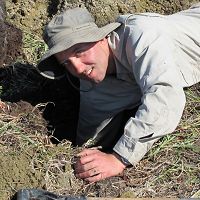Jepsen et al., 2016
Hydrogeologic influence on changes in snowmelt runoff with climate warming: Numerical experiments on a mid-elevation catchment in the Sierra Nevada, USA
Jepsen, S. M.; Harmon, T. C.; Meadows, M. W.; Hunsaker, C. T. (2016)
Hydrology 533, 332-342. DOI 10.1016/j.jhydrol.2015.12.010
-
Sierra, COLLABORATOR
-
Sierra, COLLABORATOR
-
Sierra, STAFF
-
Sierra, INVESTIGATOR
Abstract
The role of hydrogeology in mediating long-term changes in mountain streamflow, resulting from reduced snowfall in a potentially warmer climate, is currently not well understood. We explore this by simulating changes in stream discharge and evapotranspiration from a mid-elevation, 1-km2 catchment in the southern Sierra Nevada of California (USA) in response to reduced snowfall under warmer conditions, for a plausible range in subsurface hydrologic properties. Simulations are performed using a numerical watershed model, the Penn State Integrated Hydrologic Model (PIHM), constrained by observations from a meteorological station, stream gauge, and eddy covariance tower. We predict that the fraction of precipitation occurring as snowfall would decrease from approximately 47% at current conditions to 25%, 12%, and 5% for air temperature changes of +2, +4, and +6 °C. For each of these warming scenarios, changes in mean annual discharge and evapotranspiration simulated by the different plausible soil models show large ranges relative to averages, with coefficients of variation ranging from -3 to 3 depending on warming scenario. With warming and reduced snowfall, substrates with greater storage capacity show less soil moisture limitation on evapotranspiration during the late spring and summer, resulting in greater reductions in annual stream discharge. These findings indicate that the hydrologic response of mountain catchments to atmospheric warming and reduced snowfall may substantially vary across elevations with differing soil and regolith properties, a relationship not typically accounted for in approaches relying on space-for-time substitution. An additional implication of our results is that model simulations of annual stream discharge in response to snowfall-to-rainfall transitions may be relatively uncertain for study areas where subsurface properties are not well constrained.
Citation
Jepsen, S. M.; Harmon, T. C.; Meadows, M. W.; Hunsaker, C. T. (2016): Hydrogeologic influence on changes in snowmelt runoff with climate warming: Numerical experiments on a mid-elevation catchment in the Sierra Nevada, USA. Hydrology 533, 332-342. DOI 10.1016/j.jhydrol.2015.12.010.
Explore Further




